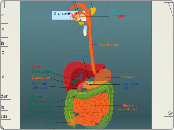
Human Nutrition
Alimentary Canal
Mouth
Physical Digestion
1) Chewing break up the food.
2) Tongue mix food and rolls food bvvinto small round masses (boli)
Chemical Digestion
Action of salivary amylase : strach ------> maltose
Oesophagus
Food passes down via peristalsis by antagonistic muscles
Circular muscles (inner layer)
Longitudinal muscles (outer layer)
Stomach
Physical Digestion
Peristalsis mixes the food with the gastric juice
Chemical Digestion
Action of pepsin : proteins ------> polypeptides
Action of rennin : soluble caseinogen ------> insoluble casein
Small Intestine
Duodenum
Chemical Digestion
Intestinal glands secrete intestinal juice - Action of enterokinase : trypsinogen ------> trypsin - Action of maltase : maltose ------>glucose - Action of lactase : lactose ------> glucose and galactose - Action of sucrase : sucrose ------> glucose and fructose - Action of erepsin : polypeptides ------> amino acids - Action of lipase : fats ------> fatty acids and glycerol
Pancreas secrete pancreatic juice - Action of amylase : starch ------>maltose - Action of trypsin : starch ------>maltose - Action of lipase : fats ------>fatty acids and glycerol
Physical Digeation
Bile salts emulsify fats into tiny droplets.
Ileum
Digested food are absorbed by the villi of the small intestine.
Glucose and amino acids are absorbed by diffusion/active transport into the blood capillaries.
Glycerol and fatty acids diffuse into the epithelium, where they recombine to formfat globules and enter lymphatic capillaries.
- The inner wall of the small intestine is highly folded. - The folds are lined with microscopic, finger-like projection called villi. - The epithelial cells of the villi, in turn, have numerous microvilli. - The epithelium of the villi is one cell thick.
Increases surface area to volume ratio for absorption
- The small intestine is long to provide sufficient time for absorption. - The intestinal wall and the villi have many capillaries to carry away the absorbed food substances. In each villus is a lacteal or lymphatic capillary surrounded by blood capillaries. This continual transport of digested food substances maintains the concentration gradient for the absorption of digested food substances.
Large intestine
Colon Rectum
-Water and mineral salts are absorbed from undigested food material. -Faces are stored temporarily in the rectum.
Anus
Faces are egeested through the anus.
Organs and glands associated with the gut
Liver
Aid in fat digestion by secreting bile
Bile emulsifies fats
Regulate blood glucose concentration
Break down haemoglabin in red blood cells
Protein Synthesis
Deamination of amino acids
Detoxification of alcohol
Alcohol dehydrogenase break down alcohol to form acetaldehyde which may be used in cellular respiration.
Gall Bladder
Temporarily store bile
Pancreas
Produce pancratic juice.
Produce hormones
Insulin and Glucagon
Regulate blood glucose concentration
